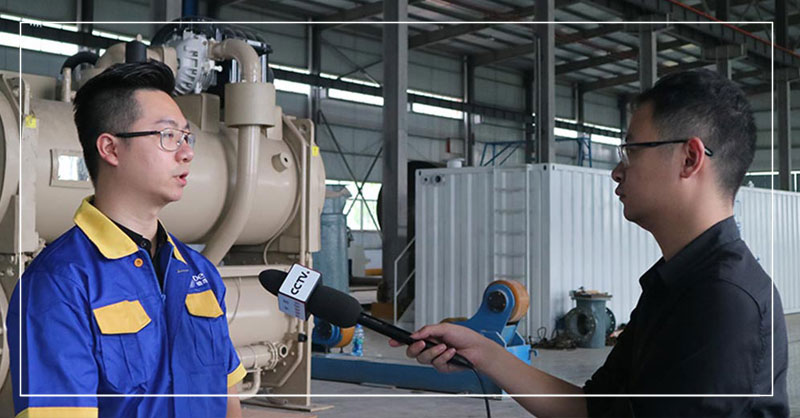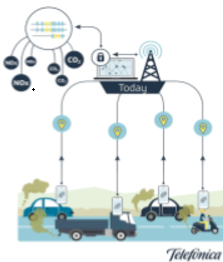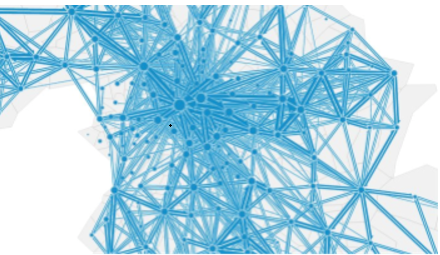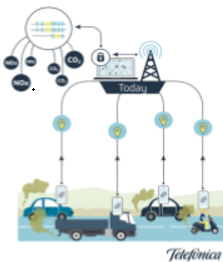-
周一 至 周六
9:00早上 - 5:30下午 -
郵箱
service@desunep.com -
聯系電話
0663-8854140
周一 至 周六
9:00早上 - 5:30下午郵箱
service@desunep.com聯系電話
0663-8854140
近日,一項利用移動網絡數據估算城市碳排放和空氣污染水平的研究新近出爐,據說此法可以大大降低實施《巴黎協議》的成本。
•該研究針對來自移動網絡數據的移動模式進行分析,用以對城市應用的不同交通運輸模式進行評估,以此對相應的污染情況和污染成因進行總結。
•這種創新的方法可使科學家在估算城市地區空氣污染物濃度時的準確率達到77%。
•此法可以擴展延伸,效率高且成本低,有助于世界各地的城市進一步了解并治理溫室氣體(GHG)排放。

大數據分析公司和蘇黎世聯邦理工大學帶領Teralytics公司、Next電信公司以及可持續發展解決方案提供商南極集團在德國的紐倫堡進行了一項研究,研究發現,移動網絡數據分析可以作為一種有效又省錢的二氧化碳和氮氧化合物估算方法。為此,Teralytics對用戶通過手機接打電話、收發短信息和瀏覽網頁生成的電信數據進行了匿名收集與研究,借以完善原始數據,通過人的移動模式去分析其經常乘坐的不同交通工具,如火車或汽車等。將這些信息與不同運輸模式的排放量數據結合在一起,他們就能估計出城市空氣污染和溫室氣體的排放量

圖一:Teralytics公司和Next電信公司在德國有多個涉及到消費者數據的項目。出于社會和經濟利益將數據加以應用,可以利用科學加快氣候保護的步伐。
因為每種形式的運輸方式所產生的二氧化碳和氮氧化物排放量是唯一的,所以對城市運輸模式的了解是弄清排放源的重要方式。在紐倫堡進行的研究表明,利用這些信息對城市空氣污染物濃度進行估算,其精確率可高達77%。這些發現,為進一步研究大數據用于理解和最終解決環境問題(如世界各地城市中空氣污染情況)帶來了希望。尤其重要的是,較之制作精良、需要精心維護的測量站,分析和解讀數據的成本是非常低廉的。因此,這種新方法可以推廣為全國范圍內的數據分析。
“雖然我們現在的城市生活方式導致了有害溫室氣體的產生,但同時也產生了大量的行為數據。我們在Teralytics的使命就是利用這些數據造福社會,” Teralytics的首席執行官喬治.博爾茨指出,“我們從紐倫堡的調查結果顯示,這些數據可以讓城市規劃者看到人類流動是如何產生污染的。這是有效設計和實施清潔空氣及低碳戰略的重要組成部分。我們期待著對此能有進一步的研究發現。”
采用三重流程,匿名匯總來的數據首先會被Teralytics的數據科學家轉化為運動流,并在所需分析的時間段內,被識別成120萬條交通路線,如圖2所示。然后,可持續發展解決方案專家南極集團將根據德國聯邦環境部提供的關于不同交通工具排放量水平的數據,利用大氣模型來估計不同運輸方式所造成的空氣污染水平。在第三個步驟中,還將對從空氣污染測量站得到的現有數據與該方法得到的數據進行對比分析,以此確認新方法的精準度情況。經此發現,測量值精準率的關聯度高達77%左右。

圖二:紐倫堡郵編區域內的交通流歷史數據。
紐倫堡試點研究的結果為進一步研究構成了良好的基礎。繼此成功之后,該項目還從氣候KIC的低碳城市實驗室得到金融支持,將各大城市、企業、學術界和非政府組織召集在一起,共同提高環境和社會影響。有了這些支撐,研究伙伴們可以進一步將方法進行完善,聚焦于短途旅行路線,并將局部地區的排放因素,如機場、大型活動場所和各類道路車輛(電動汽車和越野車)等考慮在內。
此外,交通堵塞和紅燈等因素的影響將被將考慮在內,以便更準確地估算出一個城市的空氣污染水平。
“這項試驗的研究結果超過了我們的預期,” Teralytics的業務發展與合作伙伴關系維護專員馬克西米連.格羅斯說到 “我們有信心將此產品快速擴展到世界各地,支持城市規劃者們凈化空氣,并且以最低的成本實現巴黎協議的目標。”
除此研究之外,Teralytics公司、德國電信和弗朗霍夫研究學會針對移動網絡數據的應用研究也取得了相關成果,其中包括斯圖加特交通方面的智能數據分析。
關于研究的其他評論:
“全球約70%的溫室氣體排放都來自城市,這意味著它們在氣候保護中起著關鍵作用。在利用不斷產生的數據方面,如移動網絡數據在測量和減少城市污染水平領域方面,我們看到了巨大的潛力,”南極集團首席執行官雷納.休博格如是說。
NEXT電信負責高級數據分析業務的總經理弗洛瑞安.馬卡特指出:“在紐倫堡的試點項目已經清楚地顯示出了匿名的移動網絡數據為環境帶來的附加價值。這是來自人與人之間的數據,我們從試點結果看到了巨大的潛力,即將開始進行下一階段的研究。我們的目標是開發一款產品,供德國城市、德國各州及德國聯邦政府使用,以便更好地應對對排放污染“。(本文系中國環保網www.chinaenvironment.com 高晶獨家編譯,如需轉載,請注明出處)
原文:Interesting study on how to use big data to reduce Green House gas Emissions
New study leverages mobile network data to estimate levels of carbon emissions and air pollution in cities, an approach that could substantially reduce the cost of implementing the Paris Agreement.
• The study analyses mobility patterns derived from mobile network data to estimate the usage of different transport modes within a city and derive conclusions about the respective pollution they cause.
• This innovative methodology allowed scientists to estimate the concentration of air pollutants in urban areas with up to 77% accuracy.
• The method could provide a scalable and cost effective way to help understand and combat greenhouse gas (GHG) emissions in cities worldwide.
Big data analytics company and ETH Zurich spin-off Teralytics, Telefónica NEXT and sustainability solution provider South Pole Group conducted a study in Nuremberg, Germany that reveals the analysis of mobile network data as an effective way to estimate CO2 and NOX emissions in urban areas at very low cost. To achieve this, Teralytics examined aggregated and anonymised data, which is generated when mobile devices communicate with Telefónica’s mobile communication cells while users make calls, send texts or browse the internet. Teralytics was able to refine this raw data into human mobility patterns to understand how the different modes of transport, for instance trains or cars, are frequented. Combining this information with data on the emissions of the different transport modes, the three entities were able to estimate air pollution and GHG emissions in the city.

As each form of transportation produces a unique amount of CO2 and NOX emissions, understanding urban mobility patterns is vital to understand the source of emissions. The study in Nuremberg used this information to estimate with up to 77 per cent accuracy the concentration of air pollutants in the city. These findings encourage further exploration of how big data can be used to understand and ultimately solve environmental issues such as air pollution in cities across the world. This is particularly interesting with regards to the lower cost of analysing and interpreting data compared to the higher cost of production and maintenance of elaborate measuring stations. The novel approach could thus allow an ongoing analysis on a nationwide scale.
“While our contemporary urban lifestyles result in the generation of harmful greenhouse gasses, it also generates large amounts of behavioural data. Our mission at Teralytics is to use this data for the benefit of society,” says Georg Polzer, CEO of Teralytics. “Our findings from Nuremberg showed that this data can be used to give city planners insights into how human mobility contributes to pollution. This is a vital part to efficiently design and implement clean air and low carbon strategies. We are looking forward to further exploring this opportunity.”
Using a three-level process, the fully anonymised and aggregated data was first transformed into movement flows by the data scientists at Teralytics, identifying over 1.2 million transportation routes during the analysed time period, as depicted in Figure 2. The sustainability solution expert South Pole Group then used an atmospheric model to estimate air pollution levels caused by the usage of the different modes of transportation, taking into account meteorological data and information on the respective traffic carriers’ emission levels from the German Federal Ministry for the Environment (BMUB). In the third step, the accuracy of the method was examined by comparing the findings with existing data from air pollution measuring stations. The values measured at these stations were found to correlate up to 77 per cent with those from the Teralytics’ calculations.

The results of this pilot study in Nuremberg constitute a sound basis to further develop the methodology. Following its success, the consortium was able to secure financial support from Climate KIC’s Low Carbon City Lab (LoCaL), an initiative that brings together cities, business, academia and NGO’s to deliver high environmental and societal impact. With this backing, the research partnership will expand and improve the methodology, focusing on short travel routes and taking into account local emission factors like airports, large-scale events, and types of vehicles on the road (i.e. electric cars and SUVs). Moreover, the influence of factors such as traffic jams and red lights will be taken into account in order to make even more accurate estimations of the air pollution levels in a city.
“The results from this pilot study exceed our expectations,” says Maximilian Groth, responsible for Business Development & Partnerships at Teralytics. “We are confident that we will soon be able to scale this product to cities worldwide to support urban planners in making our air cleaner and achieving the goals of the Paris Agreement at the lowest possible cost.”
This research follows other successful studies on usage of mobile network data, including a smart data analysis for transport in Stuttgart by Teralytics, Telefónica Germany, and Fraunhofer IAO.
Additional comments on the topic:
“Approximately 70 per cent of global greenhouse gas emissions are generated in cities, meaning that they play a key role in climate protection. We see great potential in the use of continuously generated data, such as mobile network data, to measure and reduce pollution levels in cities." States Renat Heuberger, CEO of South Pole Group.
Florian Marquart, Managing Director of Telefónica NEXT for Advanced Data Analytics: “The pilot project in Nuremberg has clearly shown the specific added value of anonymised mobile network data for the environment. This is data from people for people. We see great potential in the results and will start the next phase of our research. The goal is to develop a product that German cities, German states and the German federal government can use to better face the challenges of emissions pollution”.